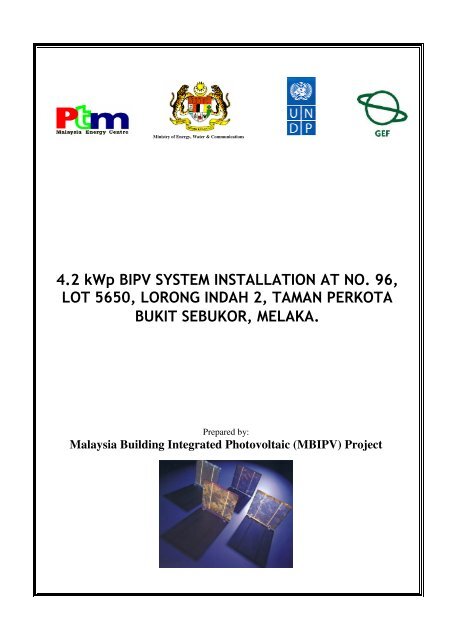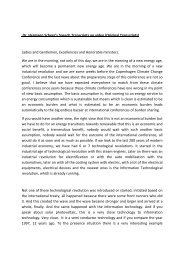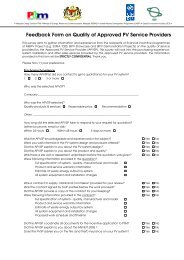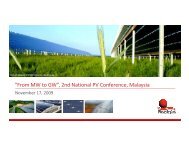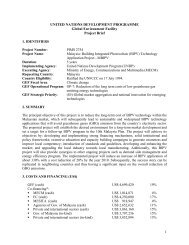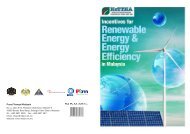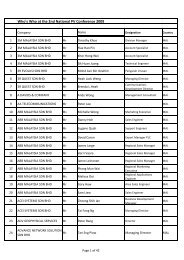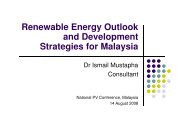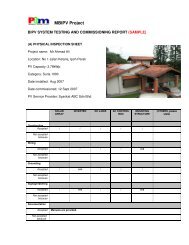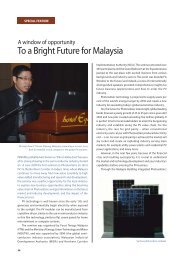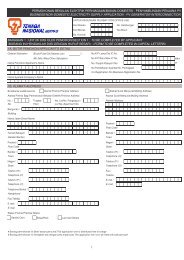Bukit Sebukor, Melaka - mbipv project
Bukit Sebukor, Melaka - mbipv project
Bukit Sebukor, Melaka - mbipv project
Create successful ePaper yourself
Turn your PDF publications into a flip-book with our unique Google optimized e-Paper software.
Ministry of Energy, Water & Communications<br />
4.2 kWp BIPV SYSTEM INSTALLATION AT NO. 96,<br />
LOT 5650, LORONG INDAH 2, TAMAN PERKOTA<br />
BUKIT SEBUKOR, MELAKA.<br />
Prepared by:<br />
Malaysia Building Integrated Photovoltaic (MBIPV) Project
MILESTONE REPORT<br />
for<br />
4.2 kWp BIPV System Installation at<br />
No 96, Lot 5650, Lorong Indah 2, Taman<br />
Perkota, <strong>Bukit</strong> <strong>Sebukor</strong> <strong>Melaka</strong>.<br />
Malaysia Building Integrated Photovoltaic<br />
(MBIPV) Project<br />
UNDP Project No. MAL/04/G31 (Project ID: 42090)<br />
Project Task Component 2 (Sub-activity 2.6)<br />
Prepared by<br />
PTM<br />
Checked & Approved by<br />
PTM<br />
Release Status<br />
Azah Ahmad, Senior Officer<br />
(Vincent Tan, Technical Adviser C2)<br />
(Daniel Ruoss, International Consultant)<br />
Ahmad Hadri Haris,<br />
National Project Leader<br />
Final<br />
Date 19 th July 2007<br />
Distribution List NSC<br />
PRC
IEA PVPS Task 10, Activity 4.1 – 4.2 kWp (Malaysia) July 2007<br />
CASE STUDY FOR 4.2 kWp BUNGALOW HOUSE<br />
AT BUKIT SEBUKOR,<br />
MELAKA, MALAYSIA.<br />
“The IEA PVPS Task 10 (Malaysia)”<br />
1. General information<br />
Name of the <strong>project</strong> : ‘4.2 kWp BIPV System at Bungalow House’<br />
Location<br />
: <strong>Bukit</strong> <strong>Sebukor</strong> <strong>Melaka</strong>, Malaysia<br />
Project type<br />
: Building Integrated PV (BIPV)<br />
Peak power installed : 4.2 kWp<br />
Start of operation : 27 th June 2007<br />
2. Added value<br />
This 4.2kWp BIPV system was installed by the initiative of the house owner and his spouse<br />
who are medical practitioners and has strong interest to promote environment and clean<br />
energy. Moreover, they are very supportive of energy efficiency. Their BIPV house was<br />
constructed by a local contractor which incorporates passive energy efficiency features.<br />
3. Economic issues<br />
This private initiative BIPV <strong>project</strong> received some financial support from Malaysia Energy<br />
Centre (PTM) under the Malaysia Building Integrated Photovoltaic (MBIPV) Project. In<br />
addition, this <strong>project</strong> also received technical assistance from the MBIPV Project for<br />
interconnection to the National Utility Company (TNB) on net-metering basis.<br />
The system price for this 4.2 kWp system is shown in Table 1 below.<br />
Table 1: BIPV system price (in Malaysian Ringgit).<br />
Item<br />
Unit price Qty Total price %<br />
(RM)<br />
(RM)<br />
PV modules (175Wp each) 3,307.50 24 units 79,380 63<br />
Inverter (Fronius IG40) 12,000 1 unit 12,000 9.5<br />
Mounting structures 22,020 1 lot 22,020 17.5<br />
Electrical, design and others 12,600 1 lot 12,600 10<br />
System price (4.2 kWp) 126,000 100<br />
Price per kWp system 30,000 -<br />
Note: 1USD is equivalent to RM3.458 (as at 30 th June 2007 from www.bnm.gov.my)<br />
Page 3 of 11
IEA PVPS Task 10, Activity 4.1 – 4.2 kWp (Malaysia) July 2007<br />
This <strong>project</strong> received financial assistance equivalent to RM33,868.80 (26.8% from total<br />
system cost) and technical consultation from the MBIPV <strong>project</strong>.<br />
4. Architecture<br />
The bungalow is a double storey house located at a hilltop at <strong>Bukit</strong> <strong>Sebukor</strong>, <strong>Melaka</strong>. It was<br />
designed by a private architect with inputs from the house owner.<br />
Front view.<br />
Side view.<br />
5. Energy calculations<br />
The expected electricity production is calculated as follows:<br />
Total number of PV modules installed 24 units each 175 Wp<br />
Total PV capacity installed 4.2 kWp<br />
Expected annual energy yield 4,790 kWh/year<br />
Expected daily energy production 13.1 kWh/day<br />
Please refer to Annex 1 for detail calculation.<br />
6. Solar modules and inverter<br />
i) PV modules<br />
A total of 24 units each 175 Wp mono-crystalline solar modules are used to cover an area of<br />
about 32 m 2 as shown in Figure 1.<br />
The technical specifications are as follows:<br />
Manufacturer/model: Sharp NTR 5E3E (175 Wp)-standard<br />
Power rating: 175 Wp<br />
Type: mono-crystalline with frame<br />
Dimension (L×W×D): 1575×826×46 mm<br />
Page 4 of 11
IEA PVPS Task 10, Activity 4.1 – 4.2 kWp (Malaysia) July 2007<br />
Weight: 17 kg<br />
Certifications: IEC 61215<br />
Bypass diode: included<br />
Figure 1: PV modules.<br />
PV arrays looking from the ground.<br />
ii) Grid connected inverter<br />
The system uses one unit of grid connected inverter rated at 3,800 W as shown in Figure 2<br />
with the technical specifications as stated below.<br />
Manufacturer/model: Solarmax 4200C<br />
MPP range: 90 to 560 Vdc<br />
Max input voltage: 600 Vdc<br />
Nominal power output: 3,800 Wac<br />
Max power output: 4,180 Wac<br />
Cooling: Thermal convection<br />
Dimension (L×W×D): 550×250×200 mm<br />
IP rating: IP54<br />
Weight: 14.5 kg<br />
Certifications: EN 61000-6-1, EN 61000-6-3, EN 61000-3-2, EN 50178<br />
Page 5 of 11
IEA PVPS Task 10, Activity 4.1 – 4.2 kWp (Malaysia) July 2007<br />
Figure 2: Inverter – Solarmax 4200C.<br />
Solarmax 4200C inverter.<br />
7. Mounting Structure<br />
Inverter and DC/AC combiner box.<br />
The PV modules, inclined at 14 degrees are mounted on stainless steel structures about 7 cm<br />
above metal deck roof. The mounting brackets are welded to the mounting structure and<br />
screwed to the metal deck. Waterproofing is not an issue as the main roof is made of concrete.<br />
The access to the mounted PV arrays is easy and this helps to facilitate the installation and<br />
future maintenance of the BIPV systems.<br />
Figure 3: Brackets for the mounting structure.<br />
Page 6 of 11
IEA PVPS Task 10, Activity 4.1 – 4.2 kWp (Malaysia) July 2007<br />
8. Electrical design<br />
The PV modules are connected with 12 in series, 2 strings in parallel. The system is<br />
interconnected through direct-feed to the local utility, TNB’s grid.<br />
The electrical system installation was conducted by a certified electrician based on the<br />
Malaysian Standard: MS 1837:2005. The system installation and commissioning was<br />
supervised by the MBIPV technical expert. The schematic diagram is shown in Figure 4.<br />
Figure 4: Schematic diagram of the BIPV system installed.<br />
9. Tendering<br />
Not applicable.<br />
10. Grid-connection<br />
Output of the inverter was fed back to the local utility TNB distribution’s grid via direct feed.<br />
An AC kWh meter was installed to monitor the PV energy generated and the meter was<br />
located besides the TNB supply meter at the customer’s incoming supply point.<br />
Page 7 of 11
IEA PVPS Task 10, Activity 4.1 – 4.2 kWp (Malaysia) July 2007<br />
Currently in Malaysia, interconnection to the grid is only limited to net-metering basis. The<br />
net-metering (also the net customer consumption) in this case is the difference between the<br />
electricity supplied to the customer through the TNB meter measurement and the electricity<br />
recorded by the PV meter. MBIPV Project is working towards establishing a viable ‘feed-in<br />
tariff’ to enhance the investment in BIPV systems.<br />
Figure 5: TNB and PV meters are located at the gate post for ease of billing by the TNB.<br />
PV meter<br />
TNB meter<br />
11. Monitoring<br />
Since the house is still vacant, the monitoring of the BIPV system has not been fully<br />
commissioned. UiTM which has been appointed by the MBIPV Project on April 2007 will be<br />
monitoring the BIPV system commencing Q3 2007 for a minimum period of three years.<br />
12. Maintenance<br />
The owner assumes ownership and responsibility of the system.<br />
System maintenance required is very minimal. As Malaysia is located near to the equator with<br />
heavy rainfalls, the modules need no regular cleaning. A regular check on cable tightness and<br />
connection on a scheduled interval is encouraged.<br />
Page 8 of 11
IEA PVPS Task 10, Activity 4.1 – 4.2 kWp (Malaysia) July 2007<br />
13. Hightlights and lessons learned<br />
Some of the highlights for this <strong>project</strong> are summarized as follows:<br />
i. Neat and tidy combiner box.<br />
It was observed that the AC/DC cables are managed and secured properly in the combiner<br />
box.<br />
ii.<br />
To install cable lugs/connectors of the circuit breaker.<br />
The cables connecting the circuit breaker from PV meter and the fuse before TNB meter shall<br />
be installed with cable lugs/connectors and properly covered/insulated. Alternatively, to<br />
replace the circuit breaker with an approved insulated fuse or connector for safety and<br />
electrical contact reason.<br />
The connectors shall be<br />
properly covered and<br />
insulated.<br />
Page 9 of 11
IEA PVPS Task 10, Activity 4.1 – 4.2 kWp (Malaysia) July 2007<br />
iii.<br />
Cables are properly secured inside conduit.<br />
The DC cables under the PV modules are properly secured inside the conduit as reflected in<br />
the below pictures.<br />
iv.<br />
Lightning protection of the house.<br />
It was observed that the lightning protection of the house is not available. The house owner<br />
was informed and advised during the visit on 27 th June 07 (testing and commissioning was<br />
conducted together with the MBIPV <strong>project</strong>) to install the lightning protection for safety of<br />
the overall electrical system.<br />
14. Standards, regulations, recommendations, grid connection, links & references<br />
The Malaysian Standard (MS 1837: 2005) for installation of grid-connected photovoltaic (PV)<br />
system was officially published and available from September, 2005. This standard provides<br />
guidelines on BIPV installation and electrical safety requirements.<br />
Page 10 of 11
IEA PVPS Task 10, Activity 4.1 – 4.2 kWp (Malaysia) July 2007<br />
Annex 1: Calculation of expected annual energy yield of the system.<br />
• Array is rated at 4.2 kWp<br />
• Inverter efficiency: Solarmax 4200C is about 95%<br />
• Average daily maximum ambient temperature of 35 °C<br />
• Allow 5% for manufacturers tolerance and mismatch<br />
• Dirt derating of 3%<br />
• Total voltage drop of 2%<br />
Step 1: The derating of the PV array can be calculated by the following formula:<br />
P array = P a.stc × f mm × f temp × f dirt<br />
P a.stc = 4.2 kWp<br />
f mm = 0.95 (5%)<br />
f dirt = 0.97 (3%)<br />
f temp = 1 - (γ × (T cell.eff - T stc )) (γ is taken as 0.4%)<br />
= 1 - (0.4/100 x ((35 + 25) -25)) (T cell-eff = T a.day + 25 0 C)<br />
= 0.86<br />
P array = P a.stc × f mm × f temp × f dirt<br />
= 4.2 x 0.95 x 0.86 x 0.97<br />
= 3.32 kWp<br />
Step 2: The average yearly energy output of the PV array is calculated as follows:<br />
E pv = P array x H tilt<br />
P array = 3.32 kWp<br />
H tilt = 1,550 kWh/m 2 (Irradiance at Seremban, tilted at 14 degrees)<br />
E pv = P array x H tilt<br />
= 3.32 x 1,550<br />
= 5,146 kWh per annum<br />
Step 3: The sub-system efficiency can be calculated from the following formula:<br />
η pvss = η pv-inv x η inv<br />
η pvinv = 98% (2% voltage drop)<br />
η inv = 95%<br />
η pvss = η pv-inv x η inv<br />
= 98% x 95%<br />
= 93.1%<br />
Step 4: The average yearly real energy yield of the PV system is calculated as follows:<br />
E real = E pv x η pvss<br />
= 5,146 x 0.931<br />
= 4,790 kWh per annum<br />
= 13.1 kWh per day<br />
Page 11 of 11


